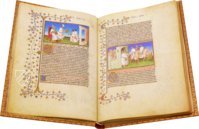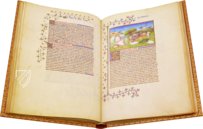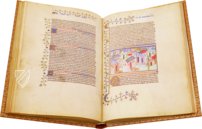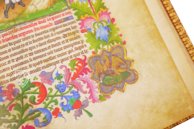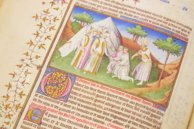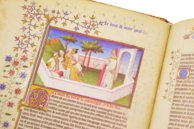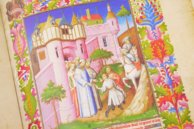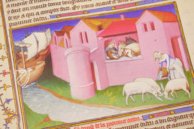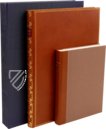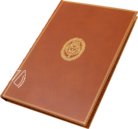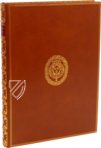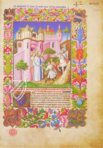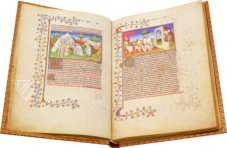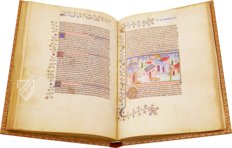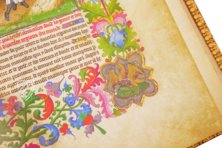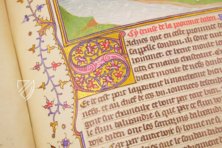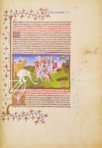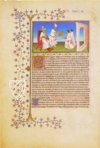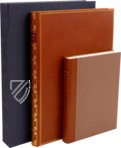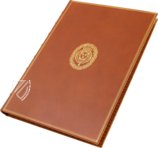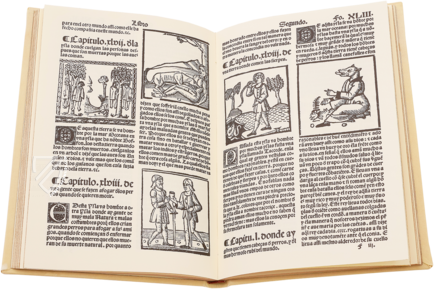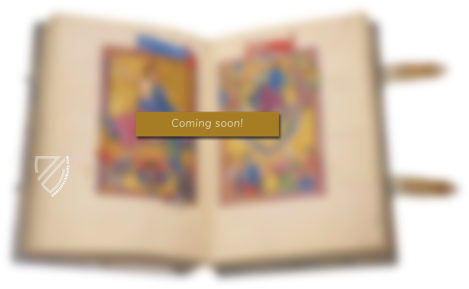Marco Polo - The Book of Wonders
(1,000€ - 3,000€)
The Book of Wonders originates from 15th century France and tells the story of the pioneer and commercial traveler Marco Polo. The most gifted book painters of the time depicted the adventures his journey in the most far-flung regions of the world in a captivating variety of colors and gold inlay.
Marco Polo - The Book of Wonders
In 15th century France, an artistic manuscript emerged that was contributed to by the most famous and influential illuminators of that time. The document recounts the story of the commercial traveler Marco Polo in 192 pages and 84 magnificent, large-format miniatures with gold inlay. It describes the journey of the pioneer in the remote regions of Asia, from his return journey through India to Venice, and regions that Marco Polo probably never visited. The work depicts a unique mixture of geographical and ethnological documentation, as well as fantastical medieval imaginings and sagas.
The Trendsetter of Book Painting
The coveted and valuable document originates from the 15th century and was prepared by the most famous French miniature painters of that time, who worked in two groups simultaneously. 37 from the total of 84 miniatures came from the Boucicaut Master, the famous virtuoso of the northern European artists who was responsible for the influential innovations of illumination from that region. He was supported by the no-less popular Mazarine Master. The second group of artists is responsible for 44 miniatures, which likewise delight through their quality and diligence. Among these painters were the Egerton Master and Bedford Master, who created through their brilliant collaboration probably their most beautiful illustrations.
A Mysterious Commissioner?
Even today, it has never been definitively explained who commissioned the so-called Book of Wonders. A high cost must certainly be reckoned for a magnificent manuscript of this quality and with the involvement of such popular illuminators, it can be assumed that the commissioner was among the nobility. A few personal symbols and hints in the work point to the Burgundian Duke John the Fearless, who was known as a great patron of art, music, and literature.
The Turbulent History of the Illuminated Manuscript
A further indication that John the Fearless was the commissioner, or at least its original owner, is found in the inventory of the Duke of Berry. Here the work is listed as a gift of the Duke of Burgundy. After the death of the Duke of Berry, the manuscript passed into the possession of the Armagnac family. The journey of the codex is not exactly known to us today, until the beginning of the 16th century it had completely disappeared. Thereafter it surfaced in the library of King Francois I and was clad in its present binding with the king’s coat of arms at the end of the 17th century.
Breathtaking Stories in Dreamlike Pictures
Even more adventurous than the fate of the work are the histories it contains. They tell of Marco Polo, who in 1271 undertook the journey to Asia with his father and uncle. Their path drove them from Palestine across Persia, Pakistan, and the Pamir Mountains to China, to the court of the fabled Mongolian ruler Kublai Khan. Afterward the young Marco Polo won the trust of the Khan, he was allowed to undertake missions for him, which took him to the remotest regions of East Asia**. In 1292, Marco Polo took himself aboard ship across the Indian Ocean to Venice, where he remained and started a family. During Venice’s war with Genoa, the pioneer was kept prisoner in a tower for three years together with a writer of the name Rusticello, whom he entrusted with his experiences. Rusticello wrote these down in French and a transcript of this manuscript came into the possession of Christopher Columbus, which inspired him to undertake his own expeditions. A transcript also served the composers of the Book of Wonders as a template, which they made come alive for the beholder through breathtaking illustrations. The full page miniatures are decorated with elements of gold leaf and give a depiction of the lands and peoples of the Orient, which was mixed with traditional European stories and immersed its readers in the fantastic adventures of Marco Polo.
Codicology
- Alternative Titles
- Book of Miracles
Marco Polo - Das Buch der Wunder
Livre des merveilles - Size / Format
- 594 pages / 42.0 × 30.0 cm
- Origin
- France
- Date
- 1410–1412
- Epochs
- Style
- Genre
- Language
- Illustrations
- 84 large and numerous smaller scale miniatures
- Patron
- John the Fearless, Duke of Burgundy (1371–1419)
- Artist / School
- Marco Polo (1254–1324) (author)
Odorico de Pordenone (1286–1331) (author)
Wilhelm von Boldensele (ca. 1285 – 1338/39) (author)
Several illuminators including the Boucicaut Master (Jacques Coene?) and his workshop, the Mazarine Master, the Egerton Master, and the workshop of the Bedford Master - Previous Owners
- Duke John of Berry (1340–1416)
Bonne of Berry (1362/1365–1435)
Count Bernard VII of Armagnac (1360–1418)
Bernard d'Armagnac (1400–1462)
Jacques d'Armagnac (ca. 1433–1477)
Charles d’Orléans, Count of Angoulême (1459–96)
King Francis I of France (1494 –1547)
Marco Polo - The Book of Wonders
Arrival at Hormuz
Hormuz was one of the most important ports and trading centers in ancient and medieval Persia. Its location on an island in the Persian Gulf made it a critical link in the trade networks between East and West. Polo visited there twice, once in 1272 (pictured here) and on his return journey in 1293. He is shown arriving by ship with elephants and camels. In fact, Polo’s party arrived in Hormuz by camel and wanted to proceed by ship, but nothing available was seaworthy enough for the long voyage.

Marco Polo - The Book of Wonders
Marco Polo Departs Constantinople
Although this fantastic manuscript is a collaboration of masters from early 15th century France, the miniature page introducing this work originates solely from the hand of the so-called Master of the Mazarine Hours. This is a wonderful specimen of the Late Gothic style during the golden age of French illumination.
The elongated figures and soft folds are typically French, and the architecture shows a worthy attempt at perspective. However, one cannot help but get lost in the marginalia, which arguably outshines the primary miniature with brightly colored tendrils accented with gold leaf. Four medallion miniatures in barbed quatrefoils depict angels with scrolls and animals with coats of arms before intricately patterned backgrounds.

#1 Marco Polo - Das Buch der Wunder; Livre des merveilles
Languages: French, German
(1,000€ - 3,000€)
- Treatises / Secular Books
- Apocalypses / Beatus
- Astronomy / Astrology
- Bestiaries
- Bibles / Gospels
- Chronicles / History / Law
- Geography / Maps
- Saints' Lives
- Islam / Oriental
- Judaism / Hebrew
- Single Leaf Collections
- Leonardo da Vinci
- Literature / Poetry
- Liturgical Manuscripts
- Medicine / Botany / Alchemy
- Music
- Mythology / Prophecies
- Psalters
- Other Religious Books
- Games / Hunting
- Private Devotion Books
- Other Genres
- Afghanistan
- Armenia
- Austria
- Belgium
- Belize
- Bosnia and Herzegovina
- China
- Colombia
- Costa Rica
- Croatia
- Cyprus
- Czech Republic
- Denmark
- Egypt
- El Salvador
- Ethiopia
- France
- Germany
- Greece
- Guatemala
- Honduras
- Hungary
- India
- Iran
- Iraq
- Israel
- Italy
- Japan
- Jordan
- Kazakhstan
- Kyrgyzstan
- Lebanon
- Liechtenstein
- Luxembourg
- Mexico
- Morocco
- Netherlands
- Palestine
- Panama
- Peru
- Poland
- Portugal
- Romania
- Russia
- Serbia
- Spain
- Sri Lanka
- Sweden
- Switzerland
- Syria
- Tajikistan
- Turkey
- Turkmenistan
- Ukraine
- United Kingdom
- United States
- Uzbekistan
- Vatican City
- A. Oosthoek, van Holkema & Warendorf
- Aboca Museum
- Ajuntament de Valencia
- Akademie Verlag
- Akademische Druck- u. Verlagsanstalt (ADEVA)
- Aldo Ausilio Editore - Bottega d’Erasmo
- Alecto Historical Editions
- Alkuin Verlag
- Almqvist & Wiksell
- Amilcare Pizzi
- Andreas & Andreas Verlagsbuchhandlung
- Archa 90
- Archiv Verlag
- Archivi Edizioni
- Arnold Verlag
- ARS
- Ars Magna
- ArtCodex
- AyN Ediciones
- Azimuth Editions
- Badenia Verlag
- Bärenreiter-Verlag
- Belser Verlag
- Belser Verlag / WK Wertkontor
- Benziger Verlag
- Bernardinum Wydawnictwo
- BiblioGemma
- Biblioteca Apostolica Vaticana (Vaticanstadt, Vaticanstadt)
- Bibliotheca Palatina Faksimile Verlag
- Bibliotheca Rara
- Boydell & Brewer
- Bramante Edizioni
- Bredius Genootschap
- Brepols Publishers
- British Library
- C. Weckesser
- Caixa Catalunya
- Canesi
- CAPSA, Ars Scriptoria
- Caratzas Brothers, Publishers
- Carus Verlag
- Casamassima Libri
- Centrum Cartographie Verlag GmbH
- Chavane Verlag
- Christian Brandstätter Verlag
- Circulo Cientifico
- Club Bibliófilo Versol
- Club du Livre
- CM Editores
- Collegium Graphicum
- Collezione Apocrifa Da Vinci
- Comissão Nacional para as Comemorações dos Descobrimentos Portugueses
- Coron Verlag
- Corvina
- CTHS
- D. S. Brewer
- Damon
- De Agostini/UTET
- De Nederlandsche Boekhandel
- De Schutter
- Deuschle & Stemmle
- Deutscher Verlag für Kunstwissenschaft
- DIAMM
- Droz
- E. Schreiber Graphische Kunstanstalten
- Ediciones Boreal
- Ediciones Grial
- Ediclube
- Edições Inapa
- Edilan
- Editalia
- Edition Deuschle
- Edition Georg Popp
- Edition Leipzig
- Edition Libri Illustri
- Editiones Reales Sitios S. L.
- Éditions de l'Oiseau Lyre
- Editions Medicina Rara
- Editorial Casariego
- Editorial Mintzoa
- Editrice Antenore
- Editrice Velar
- Edizioni Edison
- Egeria, S.L.
- Eikon Editores
- Electa
- Emery Walker Limited
- Enciclopèdia Catalana
- Eos-Verlag
- Ephesus Publishing
- Ernst Battenberg
- Eugrammia Press
- Extraordinary Editions
- Fackelverlag
- Facsimila Art & Edition
- Facsimile Editions Ltd.
- Facsimilia Art & Edition Ebert KG
- Faksimile Verlag
- Feuermann Verlag
- Folger Shakespeare Library
- Franco Cosimo Panini Editore
- Friedrich Wittig Verlag
- Fundación Hullera Vasco-Leonesa
- G. Braziller
- Gabriele Mazzotta Editore
- Gebr. Mann Verlag
- Gesellschaft für graphische Industrie
- Getty Research Institute
- Giovanni Domenico de Rossi
- Giunti Editore
- Graffiti
- Grafica European Center of Fine Arts
- Guido Pressler
- Guillermo Blazquez
- Gustav Kiepenheuer
- H. N. Abrams
- Harrassowitz
- Harvard University Press
- Helikon
- Hendrickson Publishers
- Henning Oppermann
- Herder Verlag
- Hes & De Graaf Publishers
- Hoepli
- Holbein-Verlag
- Houghton Library
- Hugo Schmidt Verlag
- Idion Verlag
- Il Bulino, edizioni d'arte
- ILte
- Imago
- Insel Verlag
- Insel-Verlag Anton Kippenberger
- Instituto de Estudios Altoaragoneses
- Instituto Nacional de Antropología e Historia
- Introligatornia Budnik Jerzy
- Istituto dell'Enciclopedia Italiana - Treccani
- Istituto Ellenico di Studi Bizantini e Postbizantini
- Istituto Geografico De Agostini
- Istituto Poligrafico e Zecca dello Stato
- Italarte Art Establishments
- Jan Thorbecke Verlag
- Johnson Reprint Corporation
- Josef Stocker
- Josef Stocker-Schmid
- Jugoslavija
- Karl W. Hiersemann
- Kasper Straube
- Kaydeda Ediciones
- Kindler Verlag / Coron Verlag
- Kodansha International Ltd.
- Konrad Kölbl Verlag
- Kurt Wolff Verlag
- La Liberia dello Stato
- La Linea Editrice
- La Meta Editore
- Lambert Schneider
- Landeskreditbank Baden-Württemberg
- Leo S. Olschki
- Les Incunables
- Liber Artis
- Library of Congress
- Libreria Musicale Italiana
- Lichtdruck
- Lito Immagine Editore
- Lumen Artis
- Lund Humphries
- M. Moleiro Editor
- Maison des Sciences de l'homme et de la société de Poitiers
- Manuscriptum
- Martinus Nijhoff
- Maruzen-Yushodo Co. Ltd.
- MASA
- Massada Publishers
- McGraw-Hill
- Metropolitan Museum of Art
- Militos
- Millennium Liber
- Müller & Schindler
- Nahar - Stavit
- Nahar and Steimatzky
- National Library of Wales
- Neri Pozza
- Nova Charta
- Oceanum Verlag
- Odeon
- Orbis Mediaevalis
- Orbis Pictus
- Österreichische Staatsdruckerei
- Oxford University Press
- Pageant Books
- Parzellers Buchverlag
- Patrimonio Ediciones
- Pattloch Verlag
- PIAF
- Pieper Verlag
- Plon-Nourrit et cie
- Poligrafiche Bolis
- Presses Universitaires de Strasbourg
- Prestel Verlag
- Princeton University Press
- Prisma Verlag
- Priuli & Verlucca, editori
- Pro Sport Verlag
- Propyläen Verlag
- Pytheas Books
- Quaternio Verlag Luzern
- Reales Sitios
- Recht-Verlag
- Reichert Verlag
- Reichsdruckerei
- Reprint Verlag
- Riehn & Reusch
- Roberto Vattori Editore
- Rosenkilde and Bagger
- Roxburghe Club
- Salerno Editrice
- Saltellus Press
- Sandoz
- Sarajevo Svjetlost
- Schöck ArtPrint Kft.
- Schulsinger Brothers
- Scolar Press
- Scrinium
- Scripta Maneant
- Scriptorium
- Shazar
- Siloé, arte y bibliofilia
- SISMEL - Edizioni del Galluzzo
- Sociedad Mexicana de Antropología
- Société des Bibliophiles & Iconophiles de Belgique
- Soncin Publishing
- Sorli Ediciones
- Stainer and Bell
- Studer
- Styria Verlag
- Sumptibus Pragopress
- Szegedi Tudomànyegyetem
- Taberna Libraria
- Tarshish Books
- Taschen
- Tempus Libri
- Testimonio Compañía Editorial
- Thames and Hudson
- The Clear Vue Publishing Partnership Limited
- The Facsimile Codex
- The Folio Society
- The Marquess of Normanby
- The Richard III and Yorkist History Trust
- Tip.Le.Co
- TouchArt
- TREC Publishing House
- TRI Publishing Co.
- Trident Editore
- Tuliba Collection
- Typis Regiae Officinae Polygraphicae
- Union Verlag Berlin
- Universidad de Granada
- University of California Press
- University of Chicago Press
- Urs Graf
- Vallecchi
- Van Wijnen
- VCH, Acta Humaniora
- VDI Verlag
- VEB Deutscher Verlag für Musik
- Verlag Anton Pustet / Andreas Verlag
- Verlag Bibliophile Drucke Josef Stocker
- Verlag der Münchner Drucke
- Verlag für Regionalgeschichte
- Verlag Styria
- Vicent Garcia Editores
- W. Turnowski Ltd.
- W. Turnowsky
- Waanders Printers
- Wiener Mechitharisten-Congregation (Wien, Österreich)
- Wissenschaftliche Buchgesellschaft
- Wissenschaftliche Verlagsgesellschaft
- Wydawnictwo Dolnoslaskie
- Xuntanza Editorial
- Zakład Narodowy
- Zollikofer AG









